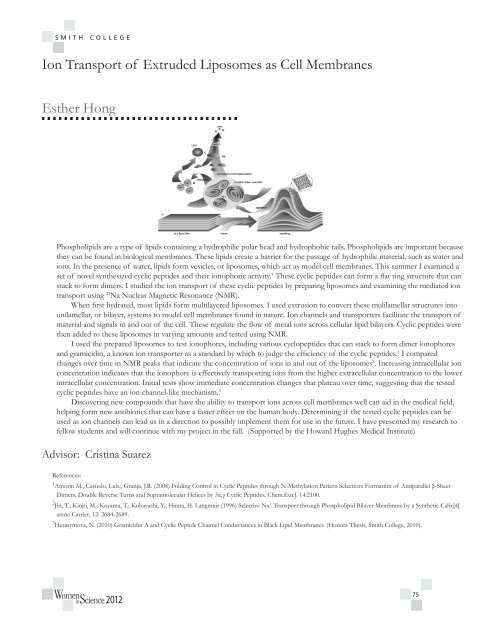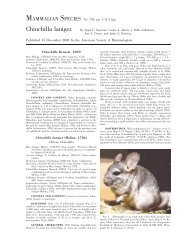Brugia Malayi - Clark Science Center - Smith College
Brugia Malayi - Clark Science Center - Smith College
Brugia Malayi - Clark Science Center - Smith College
Create successful ePaper yourself
Turn your PDF publications into a flip-book with our unique Google optimized e-Paper software.
Ion Transport of Extruded Liposomes as Cell Membranes<br />
Esther Hong<br />
Phospholipids are a type of lipids containing a hydrophilic polar head and hydrophobic tails. Phospholipids are important because<br />
they can be found in biological membranes. These lipids create a barrier for the passage of hydrophilic material, such as water and<br />
ions. In the presence of water, lipids form vesicles, or liposomes, which act as model cell membranes. This summer I examined a<br />
set of novel synthesized cyclic peptides and their ionophoric activity. 1 These cyclic peptides can form a flat ring structure that can<br />
stack to form dimers. I studied the ion transport of these cyclic peptides by preparing liposomes and examining the mediated ion<br />
transport using 23 Na Nuclear Magnetic Resonance (NMR).<br />
When first hydrated, most lipids form multilayered liposomes. I used extrusion to convert these mulilamellar structures into<br />
unilamellar, or bilayer, systems to model cell membranes found in nature. Ion channels and transporters facilitate the transport of<br />
material and signals in and out of the cell. These regulate the flow of metal ions across cellular lipid bilayers. Cyclic peptides were<br />
then added to these liposomes in varying amounts and tested using NMR.<br />
I used the prepared liposomes to test ionophores, including various cyclopeptides that can stack to form dimer ionophores<br />
and gramicidin, a known ion transporter as a standard by which to judge the efficiency of the cyclic peptides. 1 I compared<br />
changes over time in NMR peaks that indicate the concentration of ions in and out of the liposomes 2 . Increasing intracellular ion<br />
concentration indicates that the ionophore is effectively transporting ions from the higher extracellular concentration to the lower<br />
intracellular concentration. Initial tests show immediate concentration changes that plateau over time, suggesting that the tested<br />
cyclic peptides have an ion channel-like mechanism. 3<br />
Discovering new compounds that have the ability to transport ions across cell membranes well can aid in the medical field,<br />
helping form new antibiotics that can have a faster effect on the human body. Determining if the tested cyclic peptides can be<br />
used as ion channels can lead us in a direction to possibly implement them for use in the future. I have presented my research to<br />
fellow students and will continue with my project in the fall. (Supported by the Howard Hughes Medical Institute)<br />
Advisor: Cristina Suarez<br />
References:<br />
1 Amorin M., Castedo, Luis., Granja, J.R. (2008) Folding Control in Cyclic Peptides through N-Methylation Pattern Selection: Formation of Antiparallel β-Sheet<br />
Dimers, Double Reverse Turns and Supramolecular Helices by 3α,γ Cyclic Peptides. Chem.Eur.J. 14:2100.<br />
2 Jin, T.; Kinjo, M.; Koyama, T.; Kobayashi, Y.; Hirata, H. Langmuir (1996) Selective Na + Transport through Phospholipid Bilayer Membrane by a Synthetic Calix[4]<br />
arene Carrier, 12: 2684-2689.<br />
3 Herasymova, N. (2010) Gramicidin A and Cyclic Peptide Channel Conductances in Black Lipid Membranes. (Honors Thesis, <strong>Smith</strong> <strong>College</strong>, 2010).<br />
2012<br />
75

















